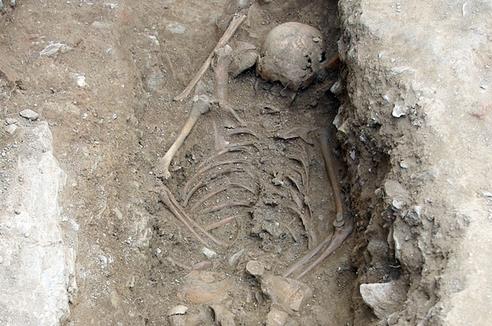Skeleton of Possible 'Witch Girl' Found
From:Discovery News NetWriter:Date:2014-10-09
An archaeological dig in northern Italy has unearthed the remains of a 13-year-old-girl buried face-down -- evidence, archaeologists say, that despite her young age, she was rejected by her community and seen as a danger even when dead.
Dubbed by Italian media as “the witch girl,” the skeleton was unearthed at the complex of San Calocero in Albenga on the Ligurian Riviera, by a team of the Pontifical Institute of Christian Archaeology at the Vatican.
The site, a burial ground on which a martyr church dedicated to San Calocero was built around the fifth and sixth centuries A.D., was completely abandoned in 1593.

The prone burial, which has yet to be radiocarbon dated, is thought to date from the late antiquity or the early Middle Ages.
“These rare burials are explained as an act of punishment. What the dead had done was not accepted by the community,” said Stefano Roascio, the excavation director. Like other deviant burials, in which the dead were buried with a brick in the mouth, nailed or staked to the ground, or even decapitated and dismembered, the face-down treatment aimed to humiliate the dead and impede the individual from rising from the grave.
“In particular, the prone burial was linked to the belief that the soul left the body through the mouth. Burying the dead face-down was a way to prevent the impure soul threatening the living,” anthropologist Elena Dellù told Discovery News.
In extreme cases, a face-down burial was used as the ultimate punishment, with the victim horrifically buried alive.
It wasn’t a treatment used on the teenage girl, however.
“The skeleton’s position rules out this possibility,” Dellù said.
Found with her hands placed on the pelvis and straight and parallel legs, the girl showed no apparent signs of a violent death in her bones. However, Dellù noticed porotic hyperostosis on the skull and orbits. These areas of spongy or porous bone tissue are the result of a severe anaemia.
“She could have suffered from an inherited blood disorder such as thalassemia or from hemorrhagic conditions. More simply, it could have been an iron lacking diet,” Dellù said.
Standing just under 5 feet tall, the young girl somehow scared the community -- perhaps it was just her pallor, her possible hematomas and fainting.
Intriguingly, her disrespectful burial was found in a privileged area, just in front of the church.
“This makes the finding even more unusual. A similar case of a teenager buried face-down in front of a church was found at the archaeological site of Pava near Siena,” Roascio told Discovery News.
“A precise dating of the skeleton and further research on similar burials might help in finding more clues,” Roascio said.
According to Caroline Arcini of Sweden's National Heritage Board, prone burials are not as rare as it may seem and have occurred across the world from 26,000 years ago up to the early 20th century.
The author of the first global study on face-down burials, Arcini has recorded more than 600 bodies who had suffered the indignity of a face-down burial from 215 grave sites. Such data suggests the phenomenon is “a conscious act, a deep-seated form of human behavior occurring in all cultures and religions,” Arcini said.
“There is a clear pattern indicating that prone burials were used for those who were different,” she added.
The researcher also recorded a case of a prone burial in front of a church.
“It was an individual male dating to the medieval period. He was killed by both sword and crossbow,” Arcini told Discovery News.
“He was buried in a cist and a bracelet partly made of gold around his wrist indicated that his social position was high,” she added.

